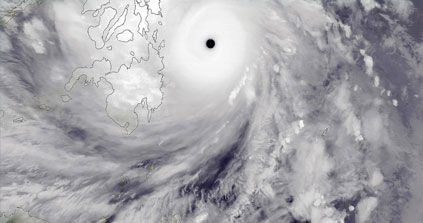
The storms in the northwestern Pacific have become stronger over the past two decades, and may increase in intensity as the planet warms in the next century.
Warming ocean temperatures seem to have intensified storms in the northwestern Pacific by about 10% in the past two decades, according to a new study. And, moderate changes in ocean temperatures under the global warming predicted by climate models may further increase average typhoon intensity by an additional 14% by 2100. The research appears in the 29 May issue of Science Advances.
Each year, typhoons in the northwestern Pacific – equivalent to hurricanes in the North Atlantic – cause considerable damage in East and Southeast Asia. Super Typhoon Haiyan of 2013 devastated large portions of the Philippines and killed at least 6,300 people.
“Accurate projections of changes in tropical cyclone intensity can benefit society and inform policy making”, said Wei Mei, first author of the study and postdoctoral scholar at Scripps Institution of Oceanography, University of California, San Diego.
The intensity of individual typhoons is difficult to predict, but it is well known that in some cases ocean temperatures play a critical role in typhoon development. There are few studies, however, on the long-term effects that changing ocean temperatures might have on these powerful storms. And, changes in storm intensity under global warming projected by climate models vary widely.
Mei and colleagues studied various atmospheric and oceanic variables (such as vertical wind shear and ocean temperatures) and compared them to observed variations in typhoon intensity since the 1950s. They then built a statistical model to look at future changes in intensity with changes in ocean water temperature. The ocean surface and subsurface temperature and typhoon intensity data show what appears to be a consistent trend: Warming ocean temperatures seem to contribute to more intense storms.
The authors used an ocean circulation model to simulate how quickly cooler water could be brought to the surface in response to the passage of a typhoon. Typhoons not only draw on ocean surface water, which has to be warm enough to get a typhoon started, but also mix up water from below the ocean surface.
Typhoon intensification is likely to increase if the subsurface water, while cooler than that at the surface, is warmer than average, the authors’ analysis suggests. Under a scenario of moderate global warming, sea temperatures would rise by 1.4 degrees Celsius at the ocean’s surface and 1.3 degrees Celsius in subsurface waters.
The study concludes that warmer upper ocean temperatures exert a strong effect on the year-to-year and decadal variations of typhoon development. The results emphasize the importance of monitoring upper ocean temperatures in particular for the prediction of typhoon intensity.
AAAS

